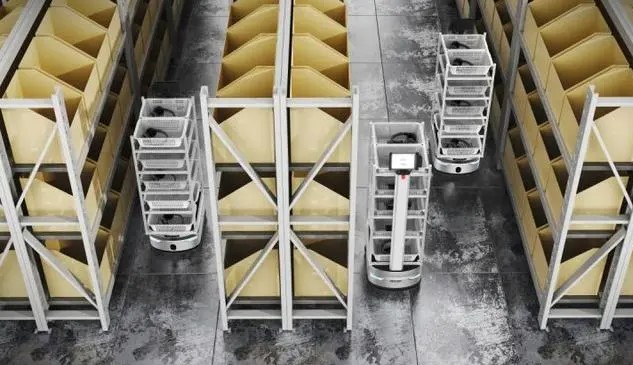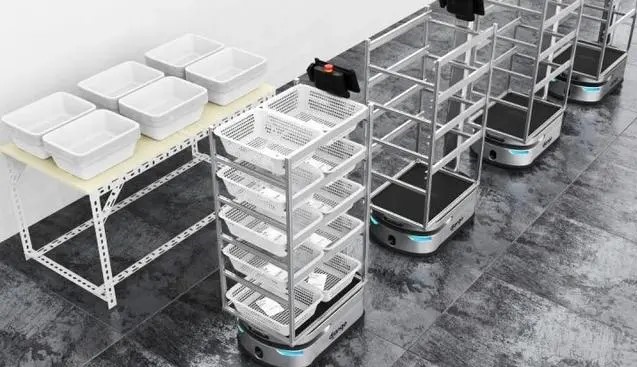According to the survey report, in 2020, 41,000 new industrial mobile robots were added to the Chinese market, an increase of 22.75% over 2019. Market sales reached 7.68 billion yuan, a year-on-year increase of 24.4%.
Today, the two most talked about types of industrial mobile robots on the market are AGVs and AMRs. But the public still doesn't know much about the difference between the two, so the editor will explain it in detail through this article.
1. Conceptual elaboration
- AGV
AGV (Automated Guided Vehicle) is an automatic guided vehicle, which can refer to an automatic transport vehicle based on various positioning and navigation technologies without the need for human driving.
In 1953, the first AGV came out and began to be gradually applied to industrial production, so AGV can be defined as: a vehicle that solves the problem of unmanned handling and transportation in the field of industrial logistics. Early AGVs were defined as "transporters moving along guide lines laid on the ground." Although it has experienced more than 40 years of development, AGVs still need to use electromagnetic induction guidance, magnetic guide bar guidance, two-dimensional code guidance and other technologies as navigation support.
- AMR
AMR, that is, autonomous mobile robot. Generally refers to warehouse robots that can position and navigate autonomously.
AGV and AMR robots are classified as industrial mobile robots, and AGVs started earlier than AMRs, but AMRs are gradually seizing a larger market share with their unique advantages. Since 2019, AMR has gradually been accepted by the public. From the perspective of market size structure, the proportion of AMR in industrial mobile robots will increase year by year, and it is expected to account for more than 40% in 2024 and more than 45% of the market by 2025.
2. The Comparison of Advantages
1). Autonomous navigation:
AGV is an automatic equipment that needs to perform tasks along a preset track and according to preset instructions, and cannot flexibly respond to on-site changes.
AMR mostly uses SLAM laser navigation technology, which can autonomously identify the map of the environment, does not need to rely on external auxiliary positioning facilities, can navigate autonomously, automatically finds the optimal picking path, and actively avoids obstacles, and will automatically go to the charging pile when the power reaches the critical point. AMR is able to perform all assigned task orders intelligently and flexibly.
2). Flexible deployment:
In a large number of scenarios requiring flexible handling, AGVs cannot flexibly change the running line, and it is easy to block on the guide line during multi-machine operation, thus affecting work efficiency, so AGV flexibility is not high and cannot meet the needs of the application side.
AMR carries out flexible deployment planning in any feasible area within the map range, as long as the channel width is sufficient, logistics enterprises can adjust the number of robot operation in real time according to the order volume, and carry out modular customization of functions according to the actual needs of customers to maximize the efficiency of multi-machine operation. In addition, as business volumes continue to grow, logistics companies can expand AMR applications at a very low new cost.
3). Application scenarios
AGV is like a "tool person" without his own thoughts, suitable for point-to-point transportation with fixed business, simple and small business volume.
With the characteristics of autonomous navigation and independent path planning, AMR is more suitable for dynamic and complex scene environments. In addition, when the operation area is large, the deployment cost advantage of AMR is more obvious.
4). Return on investment
One of the main factors that logistics companies should consider when modernizing their warehouses is return on investment.
Cost perspective: AGVs need to undergo large-scale warehouse renovation during the deployment phase to meet the operating conditions of AGVs. AMRs do not require changes to the layout of the facility, and handling or picking can be done quickly and smoothly. The human-machine collaboration mode can effectively reduce the number of employees, thereby reducing labor costs. The easy-to-operate robot process also greatly reduces training costs.
Efficiency perspective: AMR effectively reduces the walking distance of employees, allows employees to focus on higher-value activities, and effectively improves work efficiency. At the same time, the whole stage from the issuance of tasks to the completion of the system management and follow-up is implemented, which can greatly reduce the error rate of employees' operations.
3. The Future Has Come
The vigorous development of the AMR industry, relying on the background of intelligent upgrading under the wave of the big times, is inseparable from the continuous exploration and continuous progress of industry people. Interact Analysis predicts that the global mobile robot market is expected to exceed $10.5 billion by 2023, with the main growth coming from China and the United States, where AMR companies headquartered in the United States account for 48% of the market.
Post time: Mar-25-2023



